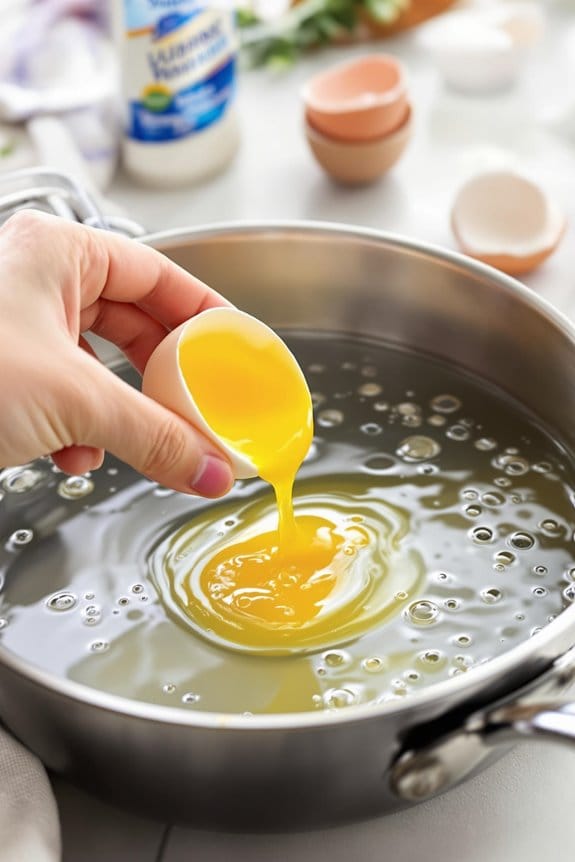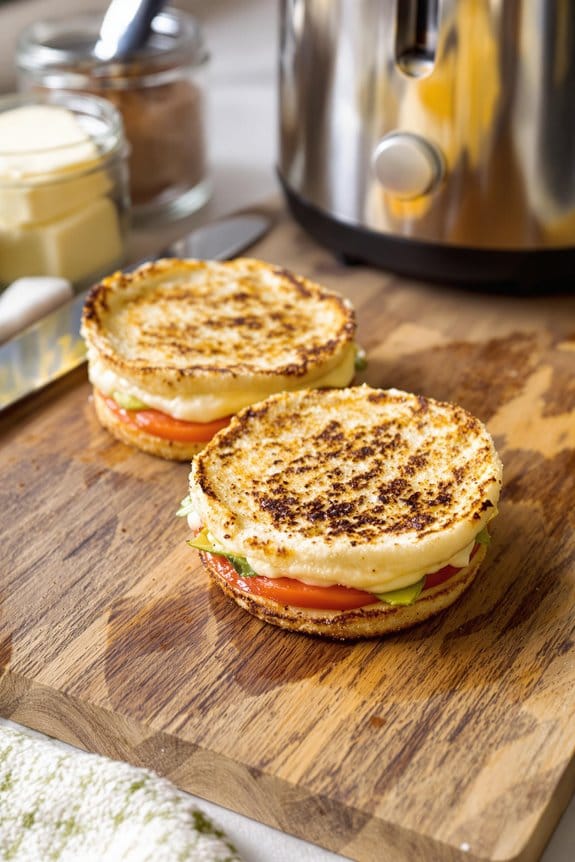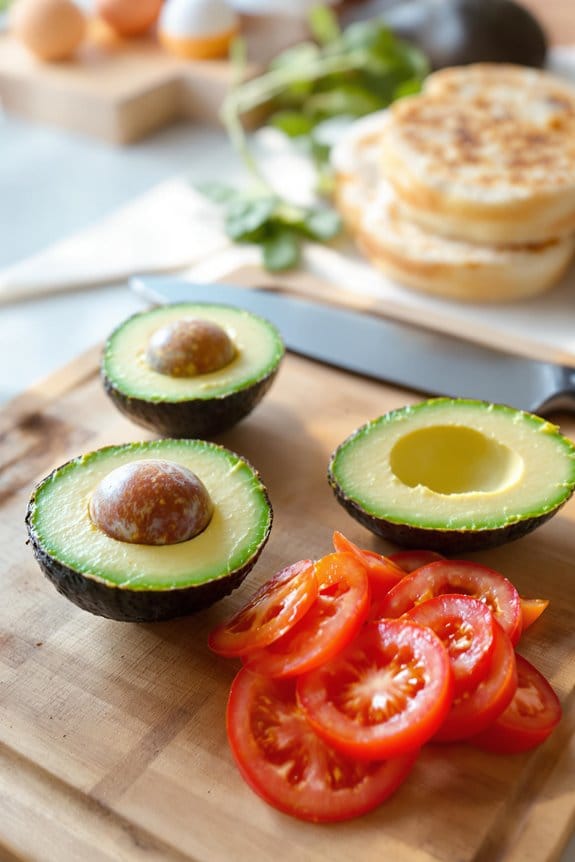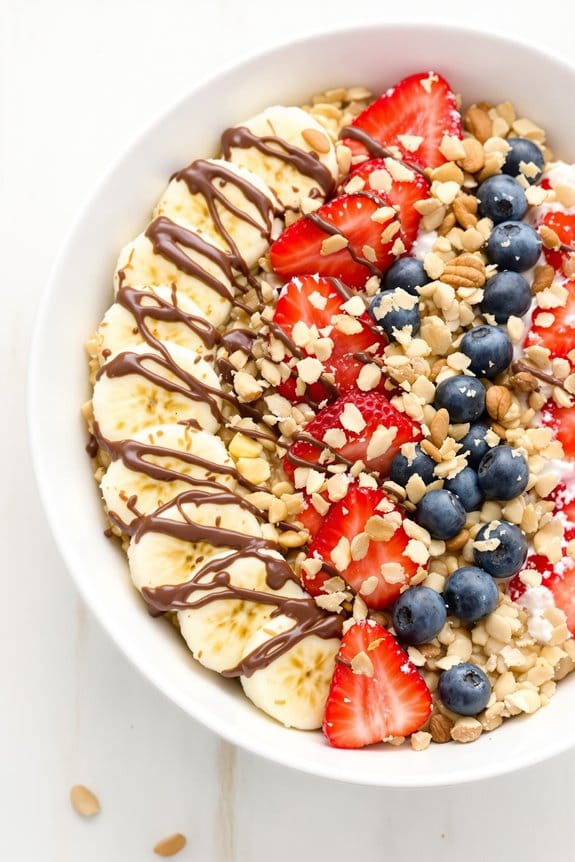Have you ever considered upgrading your breakfast game with Avocado & Tomato Eggs Benedict? Think about the traditional Eggs Benedict you’re familiar with, but enhanced with the creamy texture of avocado and the fresh, tangy bite of tomato. It’s a culinary twist that not only elevates the flavors but also packs an extra punch of nutrients. Now, while the recipe may seem straightforward, the choice of ingredients and the technique of layering flavors critically influence the final outcome. But before you get started, there’s a little secret about the sauce that might just change everything for you—
History
While the classic Eggs Benedict is a hallmark of American brunch cuisine, the addition of avocado and tomato gives it a distinct, modern twist. You mightn’t know that this variation is a relatively recent innovation in the food scene, emerging prominently as people sought healthier, more vibrant versions of traditional dishes.
Originally, Eggs Benedict itself was a product of New York City’s luxurious dining culture in the late 19th century, attributed to restaurateur Charles Ranhofer.
The inclusion of avocado and tomato, however, reflects the evolving American palate which increasingly favors ingredients that not only contribute rich flavors but also offer nutritional benefits. Avocado, rich in healthy fats and vitamins, alongside the lycopene-rich tomatoes, transforms the classic dish into a more contemporary and health-conscious choice.
This version of the dish has gathered momentum particularly on the West Coast of the United States, where these ingredients are abundant and popular in local cuisines. It’s a reflection of regional tastes adapting a classic dish to incorporate local, fresh produce.
Over time, what started as a trendy alternative has found a place in the heart of America’s brunch menu, celebrated for its freshness and modern appeal.
Recipe
Adding a twist on the traditional eggs Benedict, this Avocado & Tomato Eggs Benedict recipe brings a delightful combination of creamy avocado and fresh tomatoes atop a perfectly toasted English muffin. Not only does it promise a burst of flavor with every bite, but it also includes the rich, velvety texture of homemade hollandaise sauce, seamlessly blending with the savory taste of poached eggs.
This variation isn’t just a treat for the taste buds but also adds a colorful spectacle to your brunch table, making it an ideal choice for weekends or special occasions. The smooth, buttery texture of avocado with the sweet acidity of fresh tomatoes cuts through the richness of the eggs and sauce, offering a lighter, moreish version of a classic dish.
This dish can easily be adapted for a number of guests and remains a favorite for those looking to impress with minimal fuss. The inclusion of these fresh ingredients not only elevates the nutritional profile but also adds an invigorating twist, ensuring each bite is as satisfying as it’s delicious.
Ingredients:
- 2 English muffins, split and toasted
- 4 large eggs
- 1 ripe avocado, peeled and sliced
- 2 medium tomatoes, sliced
- 1 tablespoon white vinegar
- Salt and black pepper to taste
- Fresh chives, chopped (for garnish)
- For the Hollandaise Sauce:
- 4 egg yolks
- 1 tablespoon lemon juice
- 1/2 cup unsalted butter, melted
- Pinch of cayenne pepper
- Salt, to taste
Cooking Instructions:
Begin by preparing the hollandaise sauce. In a blender, combine egg yolks, lemon juice, cayenne pepper, and a pinch of salt. Blend until yellow and slightly thickened. Slowly add the melted butter while blending, until the sauce becomes thick and creamy; set aside.
For the poached eggs, bring water to a gentle simmer in a deep skillet and add vinegar. Crack eggs into the water and poach for 3-4 minutes until whites are set but yolks remain runny. Remove with a slotted spoon and drain on kitchen paper.
To assemble, place toasted English muffin halves on plates, top each with sliced avocado and tomato, a poached egg, and drizzle generously with hollandaise sauce. Garnish with chopped chives.
Extra Tips:
Ensuring your hollandaise sauce stays creamy and doesn’t curdle is key to a successful dish. Keep your melted butter warm, but not hot, as adding it too quickly or at a high temperature can cook the egg yolks.
If your sauce begins to separate, a few drops of cold water whisked vigorously can help salvage it. For an extra hint of luxury, add a sprinkle of smoked paprika over the final dish to complement the avocado and tomato.
Finally, pairing this dish with a light, crisp salad balances the richness and rounds out your brunch beautifully. Enjoy your cooking and the vibrant flavors!
Step 1. Prepare Poached Eggs First

Before you assemble your Eggs Benedict, you’ll need to master the art of poaching eggs. Begin by filling a deep saucepan with water; bring it to a gentle simmer. The trick is in keeping the water just hot enough to cook the eggs without boiling, as boiling water will break them apart.
Add a small dash of vinegar to the water. This helps the egg whites firm up more quickly. Crack each egg into a small cup or bowl, then gently slide it into the simmering water. You’re aiming for a controlled entry to avoid dispersing the egg whites.
Repeat with each egg, but don’t overcrowd the pan — they need room to cook evenly. Allow the eggs to poach undisturbed for about three to four minutes, depending on how runny you like your yolks. Watch the pot and don’t let the water boil.
Using a slotted spoon, lift each egg out of the water. Give it a gentle shake to drain the excess water. Place them on a paper towel-lined plate as they come out of the water. This step removes any residual water and guarantees a tidy presentation atop your Benedict.
Perfect poached eggs are within reach with a bit of patience and practice.
Step 2. Toast English Muffins

Now that your poached eggs are ready, it’s time to prepare the English muffins. Toasting them will add a delightful crunch that contrasts beautifully with the soft eggs and creamy toppings.
First, grab a serrated knife and slice each muffin in half horizontally. Be careful to keep the halves even, ensuring each side toasts evenly.
Next, heat your toaster or a skillet over medium heat. If you’re using a toaster, simply place the muffin halves in the slots and toast them to a golden brown. Keep an eye on them; it’s easy to let them go a bit too long.
If you prefer a skillet, add a small dab of butter or a light drizzle of olive oil to the pan. Place the muffin halves cut side down and press lightly. Cook them until they’re golden and crispy, usually about 2 to 3 minutes.
Once toasted, arrange the muffin halves on a plate. They’re now ready to serve as the sturdy, tasty base for your Eggs Benedict.
The slight butteriness and crisp edges will provide the perfect foundation for the layers of flavor you’ll add with your toppings.
Step 3. Slice Avocados and Tomatoes

Begin by carefully slicing the avocados and tomatoes to add a fresh, juicy layer to your Eggs Benedict.
Choose ripe but firm avocados—soft ones might be too mushy to handle neatly. Halve them lengthwise around the seed, twist to open, then remove the seed. With a spoon, carefully scoop out the flesh and place it on a chopping board. Slice each half into thin, even slices; this guarantees they’ll layer beautifully and provide a creamy texture with every bite.
For the tomatoes, pick ones that are firm and vibrant in color. Wash them first, then dry them gently to remove any excess moisture. This prevents your dish from becoming soggy.
Slice them into even rounds, about a quarter-inch thick. These will add a burst of flavor and a touch of color that contrasts wonderfully with the green of the avocado.
Step 4. Assemble on English Muffins

With your avocados and tomatoes sliced, it’s time to start building your Eggs Benedict on English muffins. First, you’ll want to toast your muffins until they’re lightly golden and crisp. This not only adds texture but also prevents them from becoming soggy once topped with the other ingredients.
Next, lay a slice or two of your ripe avocado on each muffin half. The creamy texture of the avocado pairs beautifully with the crunch of the toasted muffin. On top of the avocado, arrange a few slices of fresh tomato, offering a juicy contrast and a burst of flavor.
Now, it’s time for the eggs. If you’re preparing poached eggs, verify they’re cooked just right — ideally with runny yolks enveloped by gently set whites.
Gently place one egg atop the tomato layer on each muffin half. The warmth from the freshly poached egg will slightly meld the layers together, enhancing the overall taste and verifying a cohesive blend of flavors with every bite.
This methodical layering not only builds an appealing presentation but also verifies a harmony of textures and tastes, setting the perfect stage for the final touches in your recipe.
Step 5. Add Hollandaise Sauce

Once you’ve assembled your Eggs Benedict with avocado and tomato, it’s time to drizzle the Hollandaise sauce, which will truly transform the dish.
Begin by melting a stick of butter in a small saucepan until it’s bubbling but not brown. In a separate bowl, whisk together three egg yolks with a tablespoon of water and a tablespoon of fresh lemon juice until the mixture is thoroughly combined and slightly thickened.
Now, you’ll need to slowly blend the hot butter into the egg yolk mixture. It’s key to add the butter gradually while continuously whisking to guarantee your sauce becomes smooth and velvety rather than scrambled eggs. As you incorporate the butter, the sauce will begin to thicken. If it appears too thick, you can adjust the consistency by whisking in a few drops of warm water.
Once all the butter is incorporated and the sauce is creamy, season it with a pinch of cayenne pepper and salt to taste. This will add a gentle heat that complements the cool freshness of the tomato and creamy avocado beautifully.
Finally, pour the warm Hollandaise sauce generously over each assembled Eggs Benedict. The rich, buttery sauce doesn’t just enhance flavors; it unifies all the components on your plate, creating a mouthwatering masterpiece ready to be enjoyed.
New Recipe
- Pepperoni and Hot Honey PizzaTry the tantalizing twist of pepperoni pizza with hot honey, where sweet meets heat—how will it transform your taste buds?
Cooking Tips
To perfectly poach your eggs for Avocado & Tomato Eggs Benedict, heat water in a pan until it’s steaming but not boiling. You’ll want to add a splash of vinegar, which helps the egg whites coalesce more quickly, keeping that ideal poached shape.
Stir the water to create a gentle whirlpool before sliding your egg into the center. This trick centers the yolk and avoids wispy whites.
Now, let’s tackle the avocado. Choose avocados that feel slightly soft when squeezed but aren’t squishy. If you’re prepping in advance, squeeze a bit of lemon juice over the cut avocado to prevent browning.
When mashing it for the Benedict, keep some texture for that delightful bite.
For the tomatoes, opt for ripe but firm ones. They should give a little under pressure but still hold their shape when sliced. A dash of salt right before serving enhances their flavor without causing too much juice to seep out.
Assemble your Benedict layer by layer, ensuring the English muffin is toasted to a golden brown. This adds a crunch that contrasts wonderfully with the softness of the poached egg and avocado.
Perfecting these elements brings together a dish that’s as delightful to look at as it’s to eat.
Final Thoughts
While putting together your Avocado & Tomato Eggs Benedict might seem intimidating at first, you’ll find that the effort pays off with every delicious bite. Conquering the art of poaching eggs, mastering the velvety hollandaise, and balancing the freshness of tomatoes and avocado isn’t just cooking—it’s crafting a masterpiece on your plate.
As you reflect on the process, remember that each step you’ve taken not only enhances your culinary skills but also broadens your breakfast repertoire. The combination of creamy avocado, tangy tomatoes, and perfectly poached eggs draped in hollandaise sauce isn’t merely a meal; it’s a celebration of flavors that wake up your palate like the morning sun.
What’s more, this dish isn’t just about indulging in a luxurious breakfast. It’s about taking the time to create something extraordinary from ordinary ingredients.
It encourages you to explore and experiment with textures and tastes, teaching patience and precision along the way.








